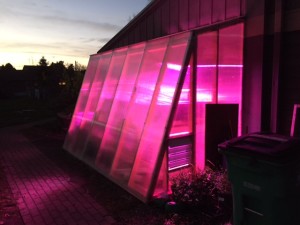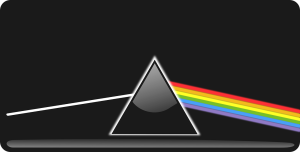Wherefore this eerie, purple glow in the greenhouse? Read on to find out why.
I have just ordered some new LED grow lights for my plant room, and when I finally got down to searching for good ones, I learned a lot about light along the way. In the next few posts, I’ll share with you some of my findings about light. Think of them as light bites. And what better than light to reflect upon near the darkest days of the year.
First, although a gardener is taught to pay attention to the nature of soil and even the chemical composition of water, light is pretty much taken as a given. It’s just there and need not be thought much of. When we take luminous matters into our own hands, whether to get a jump-start on the season by growing our own starts or whether we intend to grow plants completely indoors, we are forced to think about the nature of light. Sunlight is the gold standard, of course, and human lights are more or less successful in imitation. One might be forgiven for thinking that the brighter the light, the more effective it will be in growing plants or that the more its color is like sunlight, the better plants will respond. Neither, it turns out, is fully true.
Light is radiation or energy which our eye can detect. It falls along a measureable spectrum and is designated as energy having a wavelength between 400 (violet) and 700 nanometers (red), a nanometer being one billionth of a meter. Because light travels at one speed (the speed of light!) the colors, which have different nonometric gaits, if you will, must march faster or slower to keep up; purple and blues have to hustle to keep up with the long-legged reds and oranges. When light passes through a prism (glass or raindrop), which makes it cross two surfaces and move through a denser-than-air medium, the speed or frequency differences start to matter, the loping reds getting a bit more bent out of shape (deflected) by all those transitions than the high-energy, type-A purples. By introducing this translucent obstacle, we are able to break up the apparent uniformity of light and cause it to fall out of step into the discernible bands of the rainbow.
We can thank Pink Floyd for increasing the general scientific literacy by exposing us to the multifarious nature of light.
The light wavelengths that plants can use for photosynthesis, called PAR or photosynthetically active radiation, roughly correspond to visible light registered by the human eye, but while we optically value a rich diversity of wavelengths, plants, surprisingly, don’t care much about the middle of the spectrum. In fact, they reflect most of the green in light and thus appear that color to us. What matters to plants are the blue and the red ends of the spectrum, and a balance of these wavelengths promotes healthy, stocky growth and can take a plant through its whole lifespan.
When I was a freshman in high school, our introductory physical science class experimented on various compounds by burning them and observing the light they produced. It was a revelation to me that different compounds when burned emitted different and characteristic bands of light. That fact accounts for all manner of wonderful knowledge, such as how to make multi-colored fireworks or figuring out what a star is made of. For us plant growers it means that when electricity is passed through a filament or a gas or a diode, the nature of the atomic excitation causes certain colors, or a light profile, to be generated. Incandescents lean toward the reds and oranges; fluorescents toward the blues. The light that we find pleasing to the eye is the green-loaded, middle-of-the-visible-spectrum stuff. Plants, however, want a bluer-redder mix, and so it makes sense that purple light might actually be better for growing than the more common yellowish incandescent or blueish fluorescent tones.
More about the actual light I chose in the next light bite!


